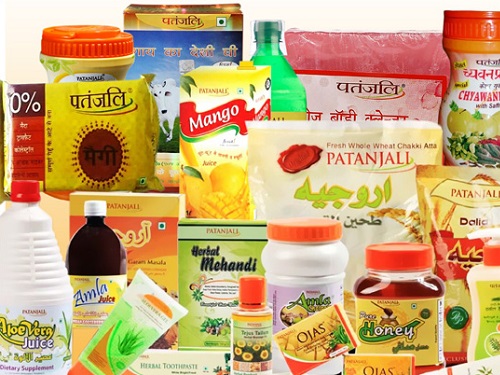Patanjali Marketing Strategy & Marketing Mix (4Ps)
Marketing Strategy of Patanjali analyzes the brand with the marketing mix framework which covers the 4Ps (Product, Price, Place, Promotion). These business strategies, based on Patanjali marketing mix, help the brand succeed in the market. Let us start the Patanjali Marketing Strategy & Mix to understand its product, pricing, advertising & distribution strategies:
Quick Glance:
Patanjali Product Strategy:
The product strategy and mix in Patanjali marketing strategy can be explained as follows:
Patanjali Ayurved is an Indian FMCG company which started in 2006. Patanjali has a diverse product offering in its marketing mix. The product range of Patanjali had more than 400 types of FMCG goods like cosmetic products, food items, haircare, skincare, toothcare etc. The company also has products which focus on baby segment, healthcare and beauty products for men and women. Patanjali also produces medicines and as per its sources, all its products are ayurvedic and free of harmful chemicals. Patanjali food product range includes biscuits, noodles, cornflakes etc.
Patanjali has 300+ medicines for treating many ailments and body conditions, from common cold to paralysis. Textile, jeans, kurta, pyjama etc is also something which the company is focused on. Hence, this gives an insight in the product mix of Patanjali. The company has been constantly innovating its product line in the FMCG industry.

Image: company website
Patanjali Price/Pricing Strategy:
Below is the pricing strategy in Patanjali marketing strategy:
Patanjali Ayurved has entered in an extremely competitive segment in the Indian FMCG industry. The main players in India in this category are the likes of HUL, P&G, Marico, ITC etc.
Patanjali has ventured into various segments and hence the pricing strategy in its marketing mix is defined by the competition in that segment. Patanjali products are priced as per competition so that it becomes easier for the customers to switch from their existing brand and adopt their products. Patanjali noodles competes with Maggi, toothpaste competes with Colgate, chywanprash competes with Dabur, cornflakes compete with Kelloggs and hence forth. This clearly shows that Patanjali has replicated the already successful existing FMCG model and is focused on giving a healthier and natural variant to its target audience. Thus the prices of Patanjali products are driven by segment, geography and most importantly competition pricing.
Read more about Patanjali
Patanjali Place & Distribution Strategy:
Following is the distribution strategy in the Patanjali marketing mix:
Patanjali has managed to reach a wide population in a short span of time. Patanjali has an excellent distribution network as it has tied up with the likes of Future group, Reliance retail, Hypercity etc. This has enabled the Patanjali brand to ensure that its products are widely available across various cities and towns in India. Close to 5000 retailers are actively promoting Patanjali products along with smaller grocery stores. With the increase in ecommerce in the Indian segment, Patanjali is also effectively increasing its presence online. This would enable customers to simply add the products to their carts and they can buy Patanjali products via COD, online payment etc which would be delivered to their doorstep. The brand has also been able to expand geographically outside India.
Patanjali products are widely available in countries like Nepal, Saudi Arabia, UAE, Middle East, Bangladesh, SriLanka etc.
Patanjali Promotion & Advertising Strategy:
The promotional and advertising strategy in the Patanjali marketing strategy is as follows:
Patanjali has considered advertising for its products as a high priority for driving sales. The promotion and branding in Patanjali marketing mix utilises all media channels like print, TV, online ads, billboards etc. Patanjali's brand ambassador is yoga guru Ramdev Baba, who has a staggering fan following, which enabled the brand to catapult in the big league within a short span. The advertisements of Patanjali has been aggressive where they have showcased the importance of using natural and ayurvedic ways of making products. Their advertisements have also been under scrutiny as they have alleged that its competitors have been using harmful products. Patanjali advertisements showcase their entire product range targeting the audience who want a healthy lifestyle by using naturally curated products. The massive advertising exercise by Patanjali has made it one of the fastest growing FMCG companies in India, with annual revenues in excess of INR 10,000 crores. The brand has good media coverage via news channels as well, which boosts the reputation & image of the company. Hence this gives an overview on the marketing mix of Patanjali Ayurved FMCG company.
About Patanjali:
Patanjali Ayurved is one the fastest growing FMCG companies in India, which focuses on food, healthcare and medicinal products. Patanjali is founded by Indian yoga guru Baba Ramdev and Acharya Balkrishna in 2006 with the aim of promoting ayurvedic products amongst consumers.
With annual revenues exceeding INR 10,000 crore, Patanjali had become one of the largest consumer goods company in India. Patanjali Ayurved has also initiated its expansion by dealership partnerships and distributor channels across India and abroad.
This article has been researched & authored by the Content & Research Team. It has been reviewed & published by the MBA Skool Team. The content on MBA Skool has been created for educational & academic purpose only.
Browse marketing strategy and 4Ps analysis of more brands similar to Patanjali. The Marketing Strategy & Mix section covers 4Ps and 7Ps of more than 800 brands in 2 categories.
Continue Reading:
The names and other brand information used in the Marketing Strategy & Mix section are properties of their respective companies. The companies are not associated with MBA Skool in any way.
What is MBA Skool?About Us
MBA Skool is a Knowledge Resource for Management Students, Aspirants & Professionals.
Business Courses
Quizzes & Skills
Quizzes test your expertise in business and Skill tests evaluate your management traits
Related Content
All Business Sections
Write for Us